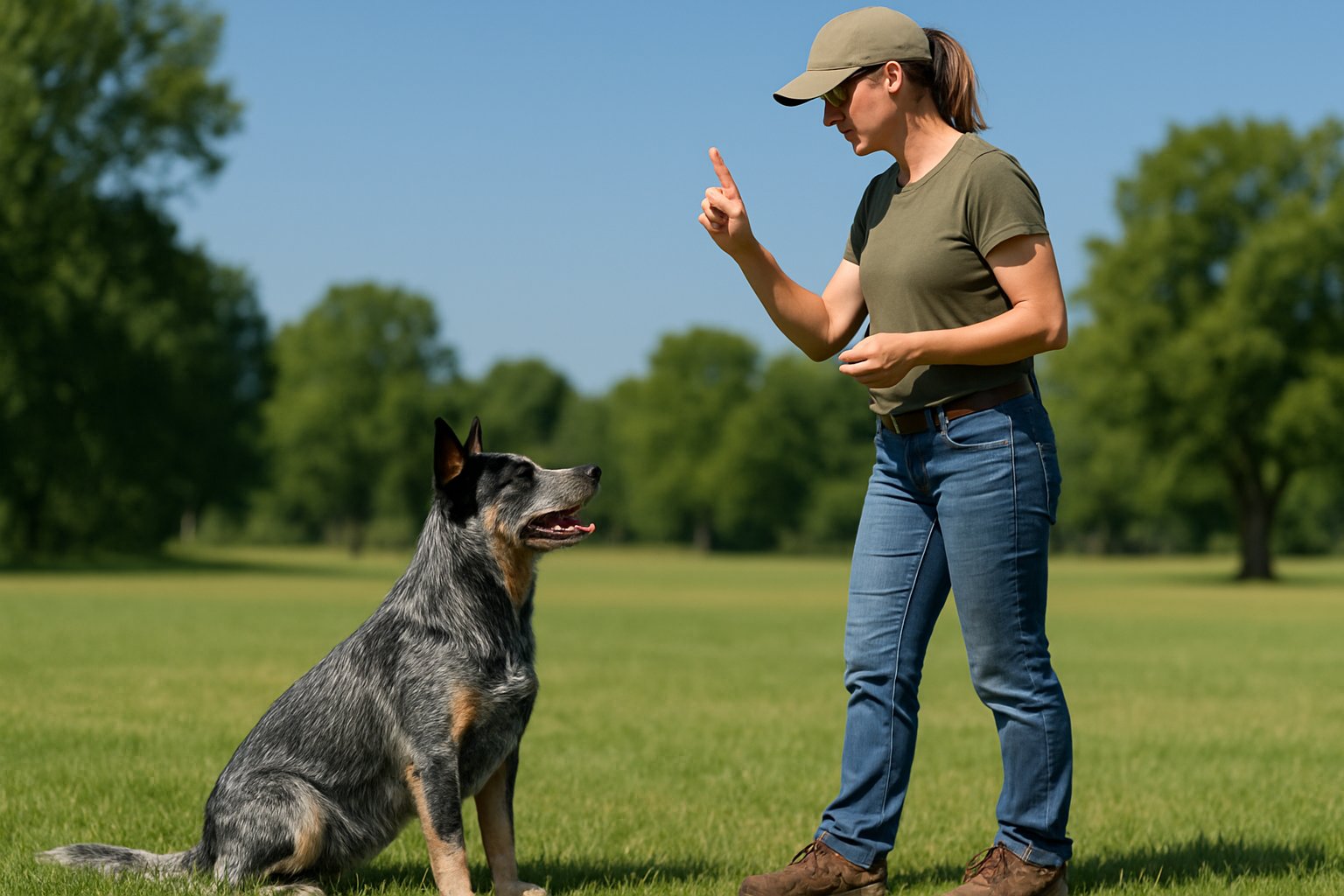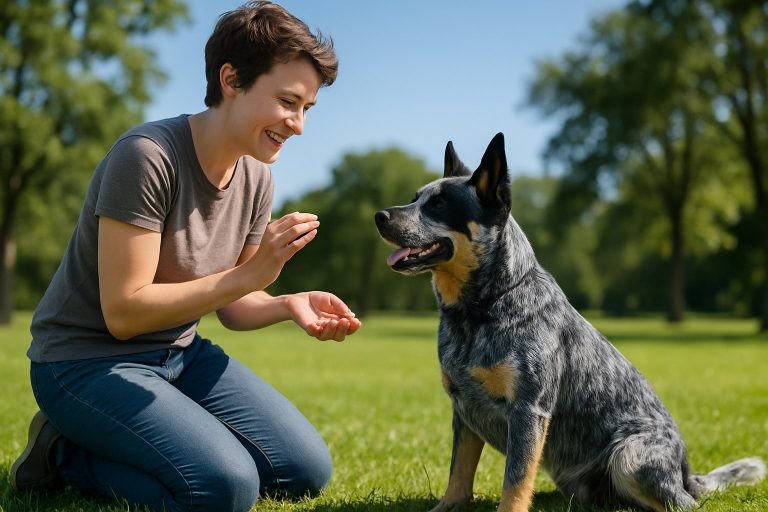Australian Cattle Dogs are smart, energetic, and hardworking. They need clear guidance and plenty of structure to succeed as happy companions. With the right approach, you can help your Australian Cattle Dog become well-behaved, confident, and a joy to have around. Training brings out the best in your dog while building a strong bond between you both.
1. Start training early to establish boundaries and good habits.
- Begin working with your Australian Cattle Dog as soon as you bring it home. These dogs are intelligent and active, so early training is key. Good habits are much easier to build when your pup is still young.
- Use positive reinforcement to teach basic commands and routines. Reward your dog with treats, praise, or toys when it follows instructions. This helps encourage the behaviors you want to see.
- Set clear boundaries from the start. For example, decide which rooms are off-limits or where your dog should sleep. Consistent limits will help your dog understand what is expected.
- Socialize your puppy by exposing it to new people, pets, and environments early. Australian Cattle Dogs need mental and physical stimulation. Good early experiences help prevent unwanted behaviors later on.
- Don’t wait for problems to appear before you start setting rules. Starting early helps your dog grow into a well-behaved and confident companion.
2. Use positive reinforcement consistently with treats and praise.
- Positive reinforcement means giving your Australian Cattle Dog something it likes right after it does what you want it to do. This can be a small treat, gentle praise, petting, or even a favorite toy. These rewards make the behavior more likely to happen again.
- This method is both effective and humane. Australian Cattle Dogs usually respond very well to treats and kind words. They are smart and active, so these rewards help them understand quickly what you expect from them.
- It is important to give the reward right away after the behavior. Timing matters. If you wait too long, your dog may not know what it did right.
- Consistency is key. Every time your dog listens or follows a command, give a reward right away. This helps build clear communication and makes training enjoyable for your dog.
- Training sessions should be short and positive. By repeating this method every time, you create a strong bond with your dog and encourage better learning.
3. Incorporate daily mental stimulation to keep them engaged.

Australian Cattle Dogs are very smart and need to use their brains every day. Without enough mental stimulation, they can get bored and may start to develop unwanted habits. You can keep your dog’s mind active by adding puzzle toys, interactive games, or teaching new tricks. These activities are helpful in training and also help your dog stay happy at home. Tasks that challenge their problem-solving skills can reduce boredom and bad behavior.
4. Teach essential commands: sit, stay, come, heel, and down.
- Australian Cattle Dogs need clear, consistent training. Start by teaching simple commands like sit, stay, come, heel, and down. These commands help keep your dog safe and make daily life easier.
- Begin training in a quiet place with few distractions. Use treats and praise as rewards when your dog follows a command. Be patient and repeat each command often for the best results.
- The “sit” command helps settle your dog and is easy for most dogs to learn. Teaching “stay” gives you better control, especially in busy or dangerous places. “Come” is important for safety, making sure your dog returns to you when called.
- “Heel” teaches your dog to walk calmly beside you and not pull on the leash. The “down” command helps calm a high-energy dog and teaches self-control.
5. Socialize with other dogs and people to reduce aggression.
- Socialization helps your Australian Cattle Dog stay calm and balanced in new situations. Exposing your dog to other dogs and people early can prevent aggressive behaviors.
- Start by introducing your dog to one calm dog in a controlled space. Let them meet at a slow pace. Watch their body language for signs of stress.
- After your dog gets used to one-on-one meetings, you can move to small group settings. Keep the experiences positive. Give treats and praise to encourage calm behavior.
- Let your dog see people of different ages, clothing, and movement patterns. This helps your Australian Cattle Dog build confidence around strangers.
- Consistent socialization can reduce fear and reactivity. Some dogs need more time than others. Stay patient and keep training sessions short.
6. Leash train using firm but gentle corrections.
- Leash training is important for Australian Cattle Dogs. These dogs are smart, strong, and have a lot of energy. They need to learn how to walk on a leash without pulling or lunging.
- Use a short, strong leash to keep good control. When your dog pulls, stop walking and wait for them to return to your side. Only move forward when the leash is loose.
- If your Australian Cattle Dog ignores the stop, use a clear verbal cue like “no” or “easy.” Avoid harsh yanking or shouting because this breed responds best to calm, steady leadership.
- Reward good behavior right away when your dog walks beside you with a loose leash. Bring small treats or use praise to encourage the right actions.
- Consistency is key. Repeat the process every time you walk. Patience and clear rules will help your dog learn what you expect.
- Keep training sessions short at first. This helps your dog stay focused and not get bored or frustrated. Ending on a positive note will build your dog’s confidence.
7. Provide a structured exercise routine to manage high energy.
- Australian Cattle Dogs are active and have high energy levels. Without regular exercise, they can become bored and develop unwanted behaviors.
- A structured routine helps your dog know what to expect each day. Set specific times for walks, fetch, and other activities. Consistency is important for this breed.
- Aim for at least one to two hours of exercise daily. Include both physical activities like running or hiking and mental challenges such as obedience training or puzzle toys.
- Changing up the routine keeps your dog interested. Try different routes on walks, or swap between games and agility exercises.
- A well-planned exercise schedule makes it easier to manage your dog’s energy. It also supports their health, fitness, and behavior.
8. Set up crate training for safety and comfort.
Crate training is a practical way to give your Australian Cattle Dog a safe place to rest. It helps with housebreaking and keeps your dog secure when you cannot watch them. Use a crate that is big enough for your dog to stand up, turn around, and lie down comfortably. Place the crate in a quiet spot in your home. Make it inviting with soft bedding and a favorite toy. Never use the crate as a punishment. Instead, help your dog see it as their personal den by offering treats and praise each time they use it.

9. Use short, frequent training sessions to maintain focus.
- Australian Cattle Dogs are smart and energetic but can lose focus during long training sessions. Keeping sessions short helps keep your dog’s attention on the task.
- Aim for just 5 to 15 minutes at a time. Frequent practice is more effective for building and keeping new skills fresh. You’ll see better progress with several short lessons a day instead of one long session.
- Making training a regular habit, such as two or three times daily, helps your dog stay engaged. Consistent practice also makes training feel routine and natural.
- Short sessions keep your dog motivated and less likely to feel tired or bored. This approach reduces frustration for both you and your Australian Cattle Dog and keeps learning positive each time.
- Using brief sessions has been shown to improve focus and concentration, so your dog is more likely to succeed. With this method, you can maintain enthusiasm and build reliable skills over time.
10. Address unwanted herding behaviors calmly and redirect.
It is common for Australian Cattle Dogs to show herding behaviors like nipping, chasing, or circling. These actions come from their strong herding instincts. While these instincts are normal, they may not be safe or wanted at home. If your dog starts herding people, pets, or objects, stay calm. Do not yell or punish your dog. Loud reactions can make the problem worse or scare your dog.



